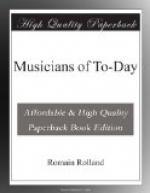And so we find that M. Saint-Saens has taken part in the vigorous attempt of modern German symphony writers to bring into music some of the power of the other arts: poetry, painting, philosophy, romance, drama—the whole of life. But what a gulf divides them and him! A gulf made up, not only of diversities of style, but of the difference between two races and two worlds. Beside the frenzied outpourings of Richard Strauss, who flounders uncertainly between mud and debris and genius, the Latin art of Saint-Saens rises up calm and ironical. His delicacy of touch, his careful moderation, his happy grace, “which enters the soul by a thousand little paths,"[137] bring with them the pleasures of beautiful speech and honest thought; and we cannot but feel their charm. Compared with the restless and troubled art of to-day, his music strikes us by its calm, its tranquil harmonies, its velvety modulations, its crystal clearness, its smooth and flowing style, and an elegance that cannot be put into words. Even his classic coldness does us good by its reaction against the exaggerations, sincere as they are, of the new school. At times one feels oneself carried back to Mendelssohn, even to Spontini and the school of Gluck. One seems to be travelling in a country that one knows and loves; and yet in M. Saint-Saens’ works one does not find any direct resemblance to the works of other composers; for with no one are reminiscences rarer than with this master who carries all the old masters in his mind—it is his spirit that is akin to theirs. And that is the secret of his personality and his value to us; he brings to our artistic unrest a little of the light and sweetness of other times. His compositions are like fragments of another world.
[Footnote 136: Harmonie et Melodie.]
[Footnote 137: C. Saint-Saens, Portraits et Souvenirs.]
“From time to time,” he said, in speaking of Don Giovanni, “in the sacred earth of Hellene we find a fragment, an arm, the debris of a torso, scratched and damaged by the ravages of time; it is only the shadow of the god that the sculptor’s chisel once created; but the charm is somehow still there, the sublime style is radiant in spite of everything."[138]
And so with this music. It is sometimes a little pale, a little too restrained; but in a phrase, in a few harmonies, there will shine out a clear vision of the past.
[Footnote 138: Portraits et Souvenirs.]
VINCENT D’INDY
“I consider that criticism is useless, I would even say that it is harmful.... Criticism generally means the opinion some man or other holds about another person’s work. How can that opinion help forward the growth of art? It is interesting to know the ideas, even the erroneous ideas, of geniuses and men of great talent, such as Goethe, Schumann, Wagner, Sainte-Beuve, and Michelet, when they wish to indulge in criticism; but it is of no interest at all to know whether Mr. So-and-so likes, or does not like, such-and-such dramatic or musical work."[139]
So writes M. Vincent d’Indy.




